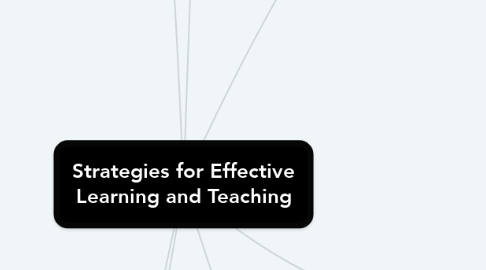
1. Teaching Strategies
1.1. Cooperative
1.1.1. Approaches
1.1.1.1. Structural
1.1.1.1.1. Group Focused
1.1.1.2. Process
1.1.1.2.1. Group Functioning
1.1.1.3. Safe Classroom Approach
1.1.1.3.1. Neurological Research
1.1.2. Role of Teacher
1.1.2.1. Facilitator
1.1.2.2. Assign Groups
1.1.2.3. Determine Objectives
1.2. Didactic
1.2.1. Direct Instruction
1.2.1.1. Phases
1.2.1.1.1. Joyce, Weil & Calhoun (2004)
1.2.2. Drill & Repetition
1.2.2.1. Cognitive Instructional Strategies
1.2.2.1.1. Encoding
1.2.3. Modelling
1.2.3.1. Categorising
1.2.3.2. Comparing
1.2.3.3. Labeling
1.2.4. Effective Questions
1.2.4.1. Types
1.2.4.1.1. Convergent
1.2.4.1.2. Divergent
1.2.4.1.3. Evaluative
1.2.4.1.4. Reflective
1.2.4.2. Appropriateness
2. Visual Teaching
2.1. David Ausabel
2.1.1. Graphic Organisers
2.1.1.1. Venn Diagrams
2.1.1.1.1. Analysis
2.1.1.1.2. Inductive
2.1.1.2. Fishbone Diagram
2.1.1.2.1. Analysis
2.1.1.2.2. Inductive
2.1.1.3. Mind Maps
2.1.1.3.1. Remember, Understand & Analysis
2.1.1.3.2. Inductive & Hierarchical
2.1.1.4. Concept Maps
2.1.1.4.1. Analysis & Evaluation
2.1.1.4.2. Inductive & Hierarchical
2.1.1.4.3. Linking Words
2.2. Audio Visual Material
2.2.1. You Tube
2.2.1.1. Educational Clips
2.2.1.1.1. Support Learning
2.2.2. Interactive Web Pages
3. ICT Teaching & Assessment Strategies
3.1. Frameworks
3.1.1. TPACK
3.1.2. SAMR
3.1.3. Authentic Learning
3.2. Internet Search Engines
3.2.1. Google
3.3. Embedding
3.3.1. Apps/Social Media
4. Unit Reflection
4.1. Learnt Content
4.1.1. Future Practice
4.1.1.1. Engaging & Preventive
4.1.1.1.1. Philosophy
4.2. Continued Learning
4.2.1. Teacher Forums
4.2.1.1. Networking
4.2.2. Tribes
4.2.3. Stay Updated with Current Research
4.2.4. Prac Placements
4.2.4.1. Application of Learning
5. Creating Emotionally Safe and Inclusive Learning Environments
5.1. Emotional Safety
5.1.1. Brain Anatomy
5.1.1.1. Hebbs Model 1970
5.1.1.1.1. No Emotional Safety = Stress
5.1.2. Maslow Hierachy of Needs
5.1.2.1. Physiological
5.1.2.2. Safety
5.1.2.3. Belonging & Love
5.1.2.4. Self Esteem
5.1.2.5. Self Actualization
5.2. Physical Environment
5.2.1. Room Layout
5.2.1.1. Behaviourist
5.2.1.1.1. Teacher as Director
5.2.1.2. Constructivist
5.2.1.2.1. Teacher as Facilitator
5.2.2. Lighting & Space
5.2.2.1. Room Size
5.2.2.2. Temperature
5.2.3. Resources
5.2.4. Ownership
5.3. Expectations
5.3.1. Pygmalion Effect
5.3.1.1. Rosenthal & Jacobson (1968)
5.3.1.1.1. Climate
5.3.1.1.2. Feedback
5.3.1.1.3. Input
5.3.1.1.4. Response Opportunity
5.4. Developing +ve Relationships
5.4.1. Boundaries, Respect & Trust
5.4.1.1. Behavioural Expectations
5.4.1.1.1. Kivunja (2015)
5.4.1.2. Enthusiasm
5.4.1.3. Rapport with Students
5.4.1.4. Academic Expectation
5.4.2. Student/Teacher Relationships
5.4.2.1. Winning Over
5.4.2.1.1. Enhances Social Relationship
5.4.2.2. Positve Cohesive Bonding
5.4.2.2.1. Strenghting Classroom Relationships
5.4.2.3. Inclusivness
5.4.2.3.1. Creating Sense of Belonging
5.4.2.4. Safe Environment
5.4.2.4.1. Ensures Sense of Self
6. Classroom Management Strategies
6.1. Prevention
6.1.1. Motivation Strategies
6.1.1.1. Behavioural
6.1.1.1.1. Reinforcement
6.1.1.1.2. Punishment
6.1.1.2. Humanist
6.1.1.3. Cognitive
6.1.1.3.1. Expectancy Value Theory
6.1.1.4. Constructionist
6.1.2. Managing Emotions
6.1.2.1. Effective Teachers
6.1.2.1.1. Invisible Discipline
6.1.2.1.2. Calm & Logical (Proactive)
6.1.2.2. Non-Effective Teachers
6.1.2.2.1. Visible Discipline
6.1.2.2.2. Angry (Reactive)
6.1.3. Goals of Student Behaviour
6.1.3.1. Misbehaviour Goals
6.1.3.1.1. Attention
6.1.3.1.2. Power
6.1.3.1.3. Revenge
6.1.3.1.4. Assumed Disability
6.2. Response
6.2.1. Theory of Bumps
6.2.1.1. Low Key Responses
6.2.1.1.1. Planned Ignore
6.2.1.1.2. Pause
6.2.1.1.3. Signal
6.2.1.1.4. Glance/Stare
6.2.1.2. Squaring Off
6.2.1.3. Choices
6.2.1.4. Implied Choices
6.2.1.5. Power Struggle
6.2.1.5.1. Diffuse don't Entertain
6.2.1.6. Informal Chat
6.2.1.7. Formal Chat
6.2.1.8. Formal Contracts
6.2.1.9. Suspension and/or Termination
6.2.1.9.1. Dependant of Organisation Policy
7. Assessment Strategy Principles
7.1. Assessments
7.1.1. Types
7.1.1.1. Formal
7.1.1.2. Informal
7.1.2. Dimensions
7.1.2.1. McConney & Ayres (1998)
7.1.2.1.1. Reliable
7.1.2.1.2. Valid (Aligned)
7.1.2.1.3. Explicit (Clear)
7.1.2.1.4. Educative
7.1.2.1.5. Feasible
7.1.2.1.6. Fair
7.2. Feedback
7.2.1. Reinforcing
7.2.1.1. Improve Through +ve Changes
7.2.2. Balancing
7.2.2.1. Improve by Avoiding Errors
7.2.3. Types
7.2.3.1. Descriptive
7.2.3.2. Corrective
7.2.3.3. Motivational
7.2.3.4. Evaluative
7.3. Moderation
7.3.1. Group Process
7.3.1.1. Refer to Criteria
7.3.1.2. Collectively Determine Grade
8. Assessment Strategies
8.1. Alternative
8.1.1. Performance Assessment
8.1.1.1. Characteristics
8.1.1.1.1. Direct Observation
8.1.1.1.2. Objective
8.1.1.2. Focus
8.1.1.2.1. Process
8.1.1.2.2. Product
8.1.1.3. Grading Assessment
8.1.1.3.1. Checklists
8.1.1.3.2. Rating Scales
8.2. Traditional
8.2.1. Subjective
8.2.1.1. Short Answer
8.2.1.2. Essay
8.2.1.2.1. Restricted Vs Extended Response
8.2.1.3. Assignment
8.2.2. Objective
8.2.2.1. True/False
8.2.2.2. Multiple Choice
8.2.2.2.1. Best Answer
8.2.2.3. Subjective
